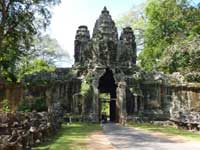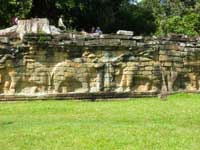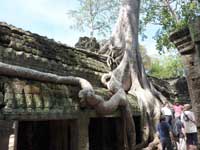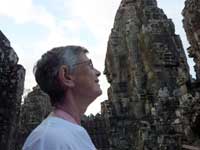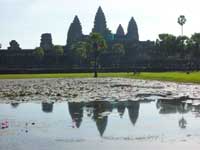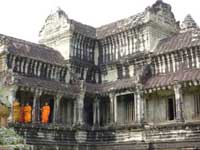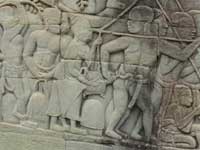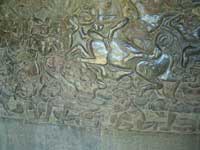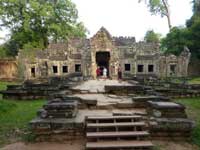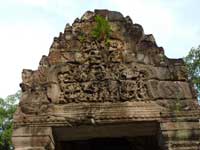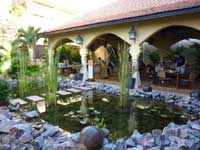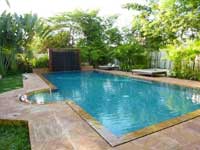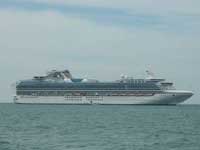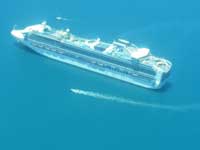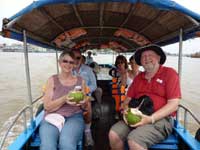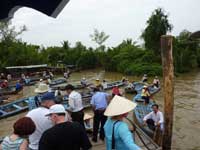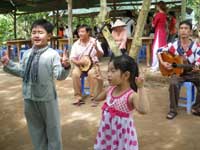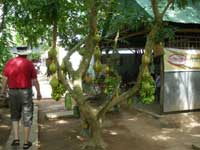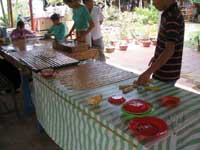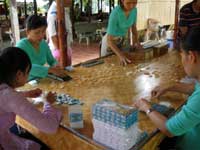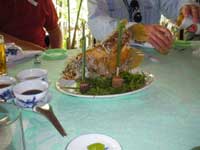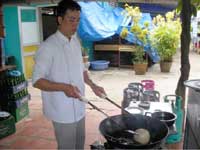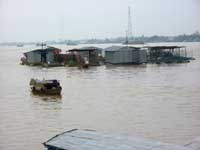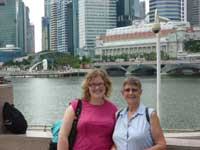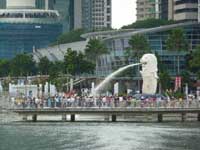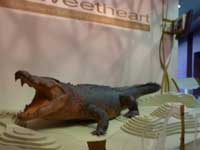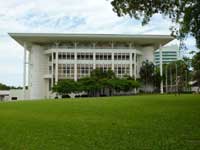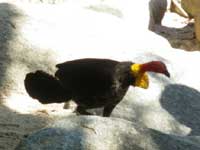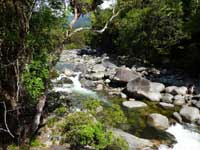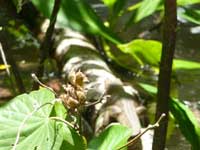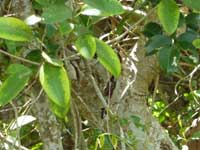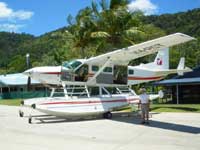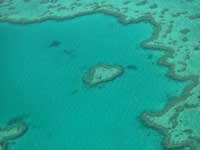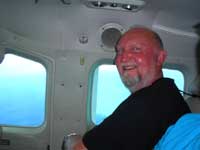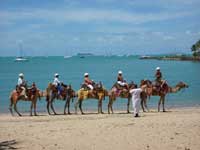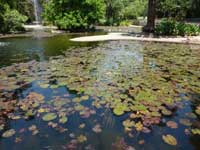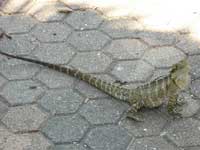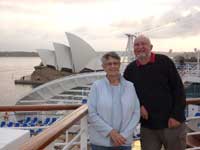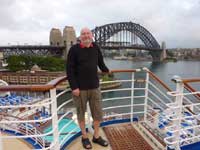A visit to Cambodia and a cruise from Bangkok to Sydney on Diamond
Princess in November and
December 2009
Angkor or Wat else? (download 1.6MB PDF file) | Angkor Map
Angkor or Wat else?
Sorry about the title - blame Martin! The journey we took in November and December 2009 falls into three parts so in order to make this travelogue more digestible it will come in three chapters:
Chapter 1- Siem Reap and 'Angkor Archaeological Park'
We flew to Bangkok and stayed the night at the sumptuous Novotel Airport Hotel ready for a crack-of-dawn, 40 minute, flight to Siem Reap in Cambodia next morning. We arrived at Siem Reap, the town for Angkor Wat, just before 9am and had a somewhat surreal experience collecting our visas: a total of 6 functionaries were needed to provide and stamp this essential document all sitting side by side ... Oh well, "It all made work for the working man to do." (With apologies to Flanders & Swann!). The process went smoothly, however; we were rapidly relieved of US$20 each Visa Fee and within half an hour we were in our air-conditioned 'limo' complete with driver and English-speaking guide, who would be available to us throughout our two-day, three-night stay. As time was short we decided to delay checking in to the hotel and start sight-seeing straight away, as soon as we had, equally swiftly, lightened our wallets to the tune of US$40 each for the three-day pass to the Angkor Archaeological Park. Have a look at the map to help you get orientated.
The temples and other structures in the area, designated the 'Angkor Archaeological Park', are the remains of the capital cities, palaces and temples of the Khmer Empire that existed in this region between the 9th and 12th centuries. Though the temples were known, and in many cases still used, by local Cambodians, they were only rediscovered by the western world in the late 19th century. One can only imagine the excitement and awe with which these magnificent remnants of an ancient civilisation were greeted by those early explorers, as they slashed their way through the dense jungle. A program of reconstruction was begun by the French, but this was put on hold during the civil war in the early 1970s and the Khmer Rouge period in the second half of that decade. It has now restarted, and different temples are being restored by various countries including France, India, Germany and Japan. The Khmer Empire had both Hindu and Buddhist periods, and many of the temples were altered to reflect the faith of new kings when they took the throne. Our guide pointed out details which showed the differences: Towers with four faces of the Buddha were a bit of a give-away, while carved Apsaras (heavenly dancers) were found in all the Hindu temples.
First we completed the 'Small Circuit' (shown as a red line on the map) and took in the temple city of Angkor Thom which has several temples. We visited one of the Royal Palaces then the Leper King and Elephant Terraces.
We then went through the Victory Gate and on to Ta Phrom Jungle Temple, one of the temples that is yet to be restored and is still overgrown by the jungle. Trees literally grow on top of and even through the walls. It was now 2pm and we were hot and tired so we checked in at our hotel for lunch, a swim and a short nap. At 5pm we were out again visiting the Bayan Temple by way of the South Gate and then on to sunset at Angkor Wat.
We finally got back to the hotel in time for a wonderful massage before dinner and an early night. Our second day started at the more civilised hour of 9 o'clock and we set off to tour Angkor Wat itself, which took the entire morning just to get an overview of what it has to offer; it takes a week or more to examine everything thoroughly.
Our guide was very good at breaking the indigestible whole into manageable morsels and he pointed out lots of details and told us the stories to go with the pictures, a couple of examples of which we have illustrated below: The left hand picture shows a soldier remonstrating with a 'camp follower' as she allows her turtle to bite his backside and the picture on the right shows a soldier removing an arrow from his comrade's posterior. Botties seem to have been something of a fixation with the artist who carved these friezes! The reason for the arrow is fairly clear as there was a constant state of war but history does not relate the fate of the turtle - was it a pet or destined for the pot? We'll never know...
We returned to the hotel for a sandwich and a swim then got back on the Temple trail and drove out to the tranquil and beautiful red temple of Banteay Samre. This was followed by another jungle temple, Phra Khan, and we returned to base via Angkor Thom and Angkor Wat at sunset - this being the Grand Circuit (the green line on the map). By this time we were all templed out and although there were lots more we could have visited, we decided to save them as a good excuse for another visit one day.
We enjoyed a short walk around the local marketplace and purchased one or two Christmas presents then wandered up and down the streets of Siem Reap town just soaking in the atmosphere before meeting up with out driver and guide for the drive 'home',
The photographs are, of course, merely representative of what we saw and an 'album' of the pick of the several hundred we took should eventually be on our website. If you are interested in learning more about this intriguing place, check out the many, beautifully illustrated books which are available. We particularly recommend 'ANGKOR- A tour of the monuments' with text by Thierry Zephir and photographs by Luca Invernizzi Tettoni, published by Archipelago Press, ISBN 978-981-4217-66-8. Lonely Planet have published several guides to Siem Reap as well as more general books covering Cambodia and the Mekong Delta, any of which may be easier to find than 'ANGKOR - A tour of the monuments', which we purchased in Siem Reap, though the publisher is the Singapore imprint of French publisher, Editions Didier Millet.
At this point we must acknowledge the contribution of our niece, Becky, who was there a week before us and provided us with lots of useful information and tips as well as the 'potted history' upon which we have drawn for this account of our own experiences.
Our hotel, the Pavillon d'Orient, is worthy of description: As we arrived, our hearts sank; the area was very 'local' and the hotel entrance was just a narrow doorway in a yellow stucco wall, altogether not at all prepossessing. As we went through the doorway, however, we were astonished by the beauty of a lush, well kept tropical garden with a delightful fishpond in the centre. We were greeted by name and the lovely Cambodian receptionist, in her attractive national dress of long skirt and fitted blouse in gold brocade showed us to comfortable chairs and gave us deliciously refreshing iced hibiscus and lemongrass tea, before we had even begun the check-in formalities. These were completed with the minimum fuss and maximum courtesy and we were given a pamphlet with a few words of 'courtesy' Cambodian and some useful tips about what is and isn't 'done' in polite society, for which we were very grateful as it's the sort of thing the guide books don't always get right. We were then taken to our room overlooking the swimming pool with its waterfall and sun loungers which were like padded, double bed sized 'divans'.
The room itself is worthy of description as it was equipped in the 'old colonial' style complete with voluminous mosquito nets hanging from a circular frame. The bed itself was huge and the sheets the finest, coolest linen with as many enormous pillows as one could wish for. A kettle and teapot and pretty cups were provided as well as fresh tea leaves and we made good use of them as we sat on our secluded verandah. A basket of pomegrates, rambutans and tiny 'finger' bananas was provided. The bathroom was exceptionally well equipped and a nice touch was that rather than plastic bottles or sachets, the soap, body lotion and shampoo came in pretty pottery dispensers; the shampoo, for example, was in a miniature 'teapot' which illustrates the care and attention to detail which typified the hotel.
The food was superb and a prawn salad was big enough for two (if only we'd known before we ordered one each) with so many huge prawns that we stopped counting after 20, and all for US$4 a plate! So good was the food that we had all our meals in the hotel. The sumptuous buffet breakfast (with cooked 'English' or Asian dishes to order) was included in the room-rate, which was itself remarkably reasonable at US$125 which also covered a car and driver at our disposal, for the duration of our stay, from 5am to 10pm and our airport transfers each way. The English-speaking guide added only US$25 to the tariff and was worth every cent. Free, unlimited internet access was just the icing on the cake.
At bedtime, we found that the room had been refreshed with fresh towels and bottled water and the bed turned down. Dressing gowns and slippers were provided and an intriguing scroll tied with red ribbon. This turned out to be a bedtime story! Each night we were given one which told of a different traditional Cambodian legend - what a lovely idea.
When we checked out we were each given one of the locally woven, brightly coloured, cotton scarves, which Cambodian people use for everything from loin cloths for the men working in the paddy fields, to 'boob tubes' and head covering for the women and hammocks and swaddling for babies. We were also asked the year of our birth and given carved coconut shell necklaces of the appropriate animal for our birth animal (the Asian equivalent of one's zodiac sign) - Martin's is a dog and Sarah's is an ox.
As you will have gathered, we loved the hotel and highly recommend it unreservedly to anyone travelling to Siem Reap; we shall certainly stay there when we eventually make a return visit.
Chapter 2 - All aboard!
Although sorry to leave Siem Reap and all its wonders, we had a cruise
to look forward to and after an early morning flight back to Bangkok (which
cost a further US$25 departure tax!) and a two hour limousine ride, we
joined the 'Diamond Princess' at Laem Chabang port. After the usual 'hurry
up and stop' which typifies all embarkation procedures, we were pleased
to get to our very comfortable cabin.
The ship is a very large one, able to accommodate 2,600 passengers and
as many crew but as it is very well designed with lots of smaller lounges
and dining rooms, one never really felt part of a throng. We made some
good friends and also lots of friendly acquaintances, which goes a long
way to making the holiday a success and is one of the best reasons for
cruising.
Sihanoukville, Cambodia
Sihanoukville was our first port of call and what a surprise it was. It had been trumpeted as a smart resort town of beautiful beaches offering a fascinating insight into the Cambodian way of life. We had, perhaps, been spoilt by the vibrancy of Siem Reap but even so, the run-down, dusty, impoverished state of this town had to be seen to be believed. There was, indeed, a smart, luxury resort, but set amid such squalor it struck us as an obscenity and not something to be admired. It was used by the elite (i.e. government ministers and corrupt officials - so much for Communism!) as well as the odd foreign tourist. The beaches could have been beautiful and an asset but in fact they were dirty and scrubby, backed by a hinterland of rubbish-strewn waste ground upon which no one had the money to build or develop into anything useful or even recreational for the local people. The market was the most interesting place in the town and we enjoyed exploring the many narrow lanes, nooks and corners with the hundreds of shops and stalls selling everything from machetes to make-up, clothing to cooking pots and food of all descriptions (and some defying description!). This was certainly an insight into the lives of the local people and we were suitably chastened when we returned to the unlimited luxury of the ship. Many of our fellow passengers were very critical that they had been subjected to such an unattractive port and we see that it is no longer included in the itinerary. We think this is a shame as it is all too easy to travel in a cocoon and the occasional reality-check is important if we are to keep the world in perspective.
Phu My, Vietnam
Phu My followed a relaxing day at sea. It was here that we had booked the only organised tour of our trip (we prefer to 'go it alone') and we were up early for our 7am departure to visit the Mekong Delta and get a taste of what life is like for those who live and work on the river. A 3 ½ hour drive through endless ribbon development (how many car repair shops does one country need? The standard of driving we encountered soon answered that question!), then through the impossibly grid-locked Ho Chi Minh City (Saigon) and on to our destination. We arrived at a very grand edifice through which we walked to embark on some very un-grand river boats for our trip to an island in the middle of the mighty Mekong. Somewhat to our dismay, we were then 'trans-shipped' onto even less grand, tiny sampans for our journey through the canals which intersect the island, to a very rickety jetty with slippery steps.
Having safely negotiated this, we walked through the jungle to a clearing where a fruit farm had been planted, growing bananas, jack fruit and durian, rambutans and ugli, coconut, papaya and mango, mangosteen, guava, starfruit and pineapple. We were then led to a table where we were given samples of some of these fruits in their dried or candied form, washed down with small glasses of green tea sweetened with honey and royal jelly; most unusual and quite delicious. Another short walk took us to a clearing where we were able to sample all the fruit in its fresh form while enjoying a selection of folk songs performed by a delightful and talented family.
Then it was time to rendezvous with our river boat again, visiting a 'factory' making coconut milk toffee en route. The process is entirely done outside, under a banana leaf shelter with all the work being done by not-very-clean hands with the only machinery being the large vat and stirrer in which the milk and sugar is boiled. We were prevailed upon to taste a sample which, having seen the very 'manual' process, we were reluctant to do and only did so for courtesy's sake. It was absolutely delicious but even so, we could not bring ourselves to buy any!
Once back on board our river boat, we were taken to a 'smart' restaurant (open air but under a corrugated iron roof) where we had the most delicious lunch of Vietnamese specialities. These included whole, steamed fish with vegetables and ginger, deliciously refreshing Vietnamese spring rolls which differ from their Chinese counterpart in that they are steamed not fried and are served cold. We also had prawns and assorted vegetables and rice as well as the house speciality, Dragons Eggs. These are made of rice starch which is kneaded to make a glutinous mass then deep fried in very hot oil so they puff up almost to the size of footballs. They are served with great pomp and "Oohs and Aahs" when they deflate when pierced. The resultant, rather flabby, greasy dough is then shared amongst all the diners at the table and devoured with great relish ... well, actually not that much relish, as it was rather tasteless and required quantities of soya sauce to make it at all palatable! Fresh fruit was served as dessert and Sarah was surprised to be given a special plate of watermelon to herself as everyone else's dessert contained pineapple, to which she is allergic. She would not have dreamt of asking for this consideration but the very thoughtful guide had remembered her making a passing reference to the allergy at the fruit farm earlier in the day, when she declined the sample offered there.
This superb lunch and the kindness of the guide somewhat made up for our disappointment in the trip; we had expected to float through the many stilt and floating villages, not be taken to what was obviously a manufactured 'tourist trap'; even though it was all very friendly and pleasant, it certainly wasn't worth the featureless drive (which took an extra hour coming back as the grid-lock in the city had worsened as it was rush hour) nor the expense.
Singapore
Singapore was next on the itinerary. Here we met up with Sarah's niece Becky, who now lives there and upon whom we were relying to guide us around and feed us pepper crab and crispy baby squid, our two favourite dishes remembered from when we had lived in Singapore in the late 1980s. We were glad to have her local knowledge as Singapore has changed beyond recognition in the last 20-odd years and we would never have found our way around even once-familiar places. She came up trumps on lunch, too, and we enjoyed a veritable feast of chilli and pepper crab, crispy fried baby squid and our favourite vegetable, kang kong (water convolvulus) done in a chilli sauce. An added bonus was that an old friend and colleague of Sarah's, Darrell Lee, was able to join us for lunch. Darrell had befriended Becky on her arrival in Singapore and, in spite of the different generations, they get on well, so it was a very relaxed and pleasant interlude which passed all too quickly. No photos of the food this time, we were too busy eating it to think of our cameras! Indeed, it was only after we had all gone our separate ways that we realised we had neglected to take a photograph of Darrell. After lunch Becky took us to look at the condominium where she shares an apartment with an Australian girl and we were most impressed with the excellent facilities she enjoys. Then, sadly, it was time to say farewell and return to the ship.
The next four days, en route to Australia, were spent at sea, sometimes within sight of land but more often, not. Crossing the Equator was celebrated and we were all given certificates to mark the occasion. We were not sure if we would like such an extended period of sea time and feared we may find it dragged but it didn't at all and we couldn't fit in all the different things we would have liked to do.
There were many lectures and activities in which one could participate, or not, as one wished and we thoroughly enjoyed the informative lectures, particularly those which told us of the history and geography of the places the cruise covered. Sarah was pleased to join a group of needle-crafters as she had recently taken up cross stitch and was given lots of encouragement, advice and even free patterns. It was also enjoyable to sit and chat whilst working on projects and she completed four handmade Christmas cards in the company of the group. Martin took the time to relax on deck, plugged into his headphones listening to his music on his MP3 player, when he wasn't on line keeping up to date with his web design work, checking emails and downloading all our photographs.
Every morning and afternoon there were trivia quizzes and we got onto a team for some brain-work. The most extraordinary aspect of these quizzes was the ferocity with which every question was queried and the answers debated; one team became quite rude and unpleasantly belligerent - it would have been funny if it hadn't been so upsetting to the poor member of the cruise staff who bore the brunt of their hectoring, to the extent that there was a threat to put a stop to the quizzes altogether if they didn't start behaving. All this and the prizes were plastic luggage tags, for Heaven's sake! Of course, the silly thing was that the contentious team were never even close to winning anyway, so quite why they got so hot under the collar is a mystery!
In addition to the other activities, there was always entertainment available, from a cocktail pianist, a sing-along ditto or a classical quartet, right through to big Broadway-style production shows, a 'pub night' with a Cockney sing-along (to the bemusement of the Americans on board!) and a huge choice of movies either on TV or the big screen in the theatre. And we were afraid of getting bored!
Chapter 3 - Trains, boats and planes
Darwin, Northern Territories
Darwin is where we next made landfall and as expected, it was warm and wet, this being the rainy season, known as simply 'The Wet'. Unexpectedly, however, the rain dried up by 9.30am and we had a gloriously sunny day, albeit a little humid. We took a taxi out of town to the excellent museum, where we 'met' Sweetheart, a misnomer if ever there was one, as he was an enormous and very ferocious crocodile (well, he was before he got 'snuffed and stuffed'). He had the unpleasant habit of biting the bottoms out of fishing boats and then snacking on the occupants when they fell in the water. We had a sneaking admiration for his crafty methods but could quite see that it was less popular with the local fishermen and their families. As well as Sweetheart, there was a fascinating exhibition of flora and fauna showing them in their native habitat. Examples of Aboriginal art and craft made another excellent exhibit but perhaps the most striking and certainly the most moving of all, was the one dedicated to Cyclone Tracy, which devastated Darwin on the night of Christmas Eve 1974. There were contemporaneous accounts of the cyclone as well as film and still photography but most stunning of all was a 'sound room' in which one stood in total darkness while a recording of the sound of the cyclone was played. We were in there for about two minutes but it was more than enough and one can only imagine how terrifying the real thing must have been. We have noticed time and again how very well presented Australian museums and galleries are and we never fail to be impressed by them.
The rest of the day in Darwin was spent exploring the Parliament Building, nicknamed The Wedding Cake by locals "...because it's full of alcohol and nuts!" This building also houses the Northern Territory Library where there is a very interesting photographic archive tracing the history of the development of the Northern Territory as well as the beautiful and sobering Commonwealth Wall Quilt. It records almost 2000 names of people who spent time in the Northern Territory during the war years and is a wonderful commemoration honouring the contribution of victims, survivors and Australia's dedicated servicemen and women. After refreshment at Speakers Corner, not a soap-box but the Parliament House café, we walked back to the ship, passing Government House and then winding down the steep road through tropical trees right down to the docks. A well-deserved swim and very late lunch rounded off an excellent day in Darwin.
Port Douglas, Queensland
Port Douglas followed two more days at sea. Although this is a port from which most people headed to Cairns, as we had been there only a couple of months before, we hired a car and headed for the wilderness of the Daintree National Forest Park. Our first stop was at the spectacular Mossman Gorge where we walked through sun-dappled forest to a platform above a river tumbling over huge boulders. Although not navigable at this stretch, good swimmers could negotiate these rapids and it looked as though the final whoosh downstream to the swimming hole would be quite exhilarating; we didn't brave it. We did walk down to the boulders at the water's edge, however to dip a toe in (cold!) and were rewarded by the sight of a bush turkey (capercaillie) wandering about, quite unconcerned.
We had intended to take a trip on a river train on the Daintree River but, sadly, it had to undergo emergency maintenance and instead we went on one of the ordinary river boats which abound on this beautiful stretch of water. We had an excellent and informative guide who gave us lots of detail about the forest trees and shrubs as well as the birds and other wildlife which abound in this protected area, including the pair of pretty Welcome Swallows which had made their nest on one of the boats roof beams. We were lucky enough to see a baby crocodile, some 30cm in length, basking on a log as well as a python curled up (rather untidily!) asleep in the fork of a tree. Some cynics claimed these were plastic 'plants' put there by the tour boat company but the little croc moved and yawned, so unless it was an exceptionally clever animatronic model, we believe he was real.
Back in Port Douglas we browsed in the shops and market and then made our way back to the ship for a swim and another late lunch. (Three cheers for the ship's all day salad buffet!).
Airlie Beach, Queensland
Airlie Beach, the port for the Great Barrier Reef and Whitsunday Islands was a stop we had been eagerly awaiting as we had booked ourselves a very special treat: a seaplane trip out over the reef and islands. This was every bit as interesting, fascinating and exciting as we had anticipated and we were delighted when the pilot did a brief touch down and take off on the water, as the flight starts and ends at an ordinary airport. He was very obliging and took us out over our ship so that we could take photographs and also over Daydream Island, where Sallie and Paul had holidayed the previous year, so we were able to get some good shots for them, too.
After what seemed to be a very quick hour and a quarter, we found ourselves back at the airport and waiting for a bus back to town. It was scheduled to arrive at 18 minutes past the hour and we were staggered when that is exactly when it arrived! An excellent market provided more Christmas presents and an un-Christmas present for Sarah, a pretty silver necklace at such a silly price it would have been rude not to. Where Blackpool has donkeys giving rides on the beach, Airlie Beach has camels and the driver was doing a roaring trade but he didn't get our custom as we've ridden camels in the desert and know what uncomfortable beasts they are ... fun to watch, though.
Brisbane, Queensland
Brisbane came next and as we had been there in September we didn't go to the galleries but had a wander round the town centre, buying nothing, then took a ride up the old City Hall clock tower which has been a 'must do' for visitors for over seventy years but which we neglected on our last visit to the city. The tower rises to 92 metres above the ground and one ascends in the beautifully restored lift. The lift travels through the clock workings which challenged the makers, who had to install four separate movements for each of the clock's four faces.
After this we caught the free Loop bus and had a ride out to the Botanical Gardens through which we enjoyed a leisurely stroll, admiring the trees and shrubs, the lovely lily pond and the magnificent iguana who posed for our photographs.
We then caught another Loop bus and completed the circuit before catching the shuttle back to the ship. Those of you who have read 'Over the Top of Oz' will remember that it was in Brisbane that we had such a tight squeeze when the ship had to turn almost within its own length to depart down river. The Diamond Princess, being somewhat larger than the Sun Princess, would not have been able to perform that feat and so we were moored an hour's drive away in the container terminal; not quite so glamorous as the Cruise Terminal but it did give us a chance to see the suburbs and outlying areas of Brisbane which we would not otherwise have done.
Sydney, New South Wales
We then had one more day at sea until we arrived at Sydney where we disembarked, not before rising at 5am and going up on deck to watch the dawn as we sailed past the Opera House and into our berth at Circular Quay.
Disembarkation was painless and we were at our hotel by 9am. A morning at Parramatta shopping centre, chosen for the long ferry ride taken to get there was followed by an afternoon in the Victorian shopping arcades in the centre of the city (we returned to the centre by train - fast but not so pleasant as the ferry). That evening we met our curry-loving friends who introduced us to another excellent Indian restaurant and a convivial evening was spent with them before an early night ready for the fast train ride to the airport and flight home to New Zealand, just in time for Paul's 40th birthday celebrations.
Angkor or Wat else? (download 1.6MB PDF file) | Angkor Map

